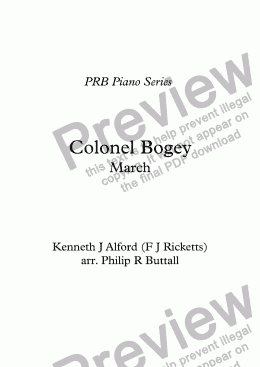Ready to print
You have already purchased this music, but not yet printed it.
This page is just a preview and does not allow printing. To print your purchase, go to the My purchases page in your account and click the relevant print icon.
PRB Piano Series: Colonel Bogey March (Alford)

Already purchased!
You have already purchased this score. To download and print the PDF file of this score, click the 'Print' button above the score. The purchases page in your account also shows your items available to print.
This score is free!
Buy this score now
PRB Piano Series: Colonel Bogey March (Alford)
$5.95
Instant download
You are purchasing high quality sheet music PDF files suitable for printing or viewing on digital devices.The Colonel Bogey March is a popular march that was written in 1914 by Lieutenant F. J. Ricketts, a British Army bandmaster who later became the Director of Music for the Royal Marines at Plymouth, my home town.
At that time service personnel were not encouraged to have professional lives outside the armed forces, so Ricketts published Colonel Bogey and his other compositions under the pseudonym Kenneth J Alford.
Supposedly, the tune was inspired by a military man and golfer who whistled a characteristic two-note phrase (a descending minor third interval, instead of shouting ’Fore!’. It is this descending interval that begins each line of the melody. The nameColonel Bogey began in the later 19th century as the imaginary "standard opponent" of the Colonel Bogey scoring system in golf, and by Edwardian times the Colonel had been adopted by the golfing world as the presiding spirit of the course. Edwardian golfers on both sides of the Atlantic often played matches against ’Colonel Bogey’. ’Bogey’ is now a golfing term meaning ’one over par’.
I have made an arrangement of Alford's original, where I have added one or two extra melodies etc, and produced this in various playing combinations under the title of The Colonel's Bogey.
The present piano transcription of Alford's March is taken essentially from the orchestral/band version, so I have added in the usual 'counter-melody', and incorporated this accordingly. One or two notes (shown as small) may be omitted to accommodate this, but I feel having the counter-melody played enhances the effect overall.



